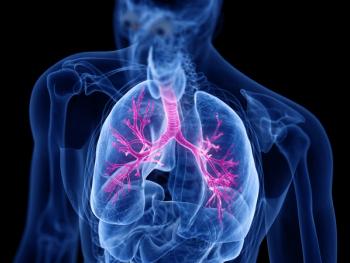
Farxiga Found to Improve Myocardial Performance During Exercise in Patients with HFpEF
Randomized trial shows Farxiga improved right ventricular pulsatile afterload and myocardial performance during exercise in patients with heart failure with preserved ejection fraction.
Patients with heart failure with preserved ejection fraction (HFpEF) treated with Farxiga (dapagliflozin) for 24 weeks experienced a reduction in pulsatile pulmonary vascular load and improved dynamic right ventricular (RV)-pulmonary artery (PA) interaction while exercising, according to the results of a clinical trial (NCT04730947) published by JAMA Cardiology.1,2 Farxiga is a sodium glucose transporter-2 (SGLT2) inhibitor initially approved by the FDA in 2014 to lower HbA1c in patients with type 2 diabetes mellitus.
Inhibiting SGLT2 has been found to lower the reabsorption of filtered glucose and increase urinary glucose excretion. Farxiga has also been found to reduce sodium reabsorption and increase the delivery of sodium to the distal tubule. While the mechanism of benefit with Farxiga in the treatment of heart failure has yet to be determined, investigators have linked its use to a decrease in sodium and volume overload, which leads to improved cardiac function.3
“Dapagliflozin reduces rest and exercise pulmonary capillary wedge pressure (PCWP), a key determinant of symptoms that is associated with increased risk of hospitalization,” the study authors wrote. “Elevation in PCWP causes pulmonary hypertension and lung vascular remodeling, ultimately driving progression to right ventricular (RV) failure and its attendant increases in mortality. However, even among patients with HFpEF and no overt RV failure at rest, limitations in RV and pulmonary artery (PA) vascular interactions are present during exercise (dynamic RV-PA uncoupling), which are important targets to prevent disease progression.”1
The investigators added that PCWP is typically abnormal during exercise in patients with HFpEF, which indicates treatments to improve exercise PCWP, such as Farxiga, may have increased efficacy on pulsatile load and RV-PA coupling. The investigator-initiated, prospective, randomized, single-center CAMEO-DAPA clinical trial compared once-daily Farxiga 10 mg vs. placebo for 24 weeks in 37 patients with HFpEF (mean [SD] age, 67.4 [8.5] years; 25 female [65%]; mean [SD] body mass index, 34.9 [6.7]). The secondary analysis analyzed the efficacy of Farxiga on pulsatile pulmonary vascular load and RV-PA coupling via simultaneous echocardiography and high-fidelity invasive hemodynamic testing with exercise. Patients with hemodynamically confirmed HFpEF with exercise PCWP of 25 mm Hg or greater were eligible for the trial.
Among the randomized participants, investigators did not find Farxiga to have an effect on PA loading or RV-PA interaction at rest. But combined with exercise, Farxiga improved PA compliance (placebo-corrected mean difference, 0.57 mL/mm Hg; 95% CI, 0.11-1.03 mL/mm Hg; P = .02) and lowered PA elastance (stiffness; −0.17 mm Hg/mL; 95% CI, −0.28 to −0.07 mm Hg/mL; P = .001).
Further, RV function improved with exercise, as investigators observed an increased PA pulsatility index (0.33; 95% CI, 0.08-0.59; P = .01) and increased exercise RVs′ indexed to PA pressure (0.09 cm·s−1/mm Hg; 95% CI, 0.02-0.16 cm·s−1/mm Hg; P = .01). There were also improvements observed in pulsatile RV load and RV-PA coupling that correlated with decreased right atrial pressure (PA elastance Pearson r = 0.55; P =.008; RVs′/PA elastance Pearson r = −0.60; P =.002) and PCWP (PA elastance Pearson r = 0.58; P <.001; RVs′/PA elastance Pearson r = −0.47; P = .02).
Farxiga was found to increase resistance-compliance time (dapagliflozin, median [IQR] change, 0.06 [0.03-0.15] seconds; placebo, median [IQR] change, 0.01 [−0.02 to 0.05] seconds; P =.046), which led to greater PA compliance for any exercise pulmonary vascular resistance, according to the study authors.
“Results of this randomized clinical trial show that treatment with Farxiga for 24 weeks favorably improved pulsatile pulmonary vascular load and RV-PA coupling during exertion in patients with HFpEF, associated with salutary reductions in central venous pressure and PCWP,” the study authors concluded. “These data suggest that improvement in ability of the right ventricle and pulmonary vasculature to respond to dynamic changes in loading conditions with exercise may represent one of the mechanisms of benefit of dapagliflozin in HFpEF.”
References
1. Reddy YNV, Carter RE, Sorimachi H, et al. Dapagliflozin and Right Ventricular–Pulmonary Vascular Interaction in Heart Failure With Preserved Ejection Fraction: A Secondary Analysis of a Randomized Clinical Trial. JAMA Cardiol. Published online July 24, 2024. doi:10.1001/jamacardio.2024.1914
2. Dapagliflozin (DAPA) Effects in HFpEF. ClinicalTrials.gov. October 12, 2023. Accessed July 29, 2024.
3. Farxiga full prescribing information. May 2020, Accessed July 29, 2024. https://www.accessdata.fda.gov/drugsatfda_docs/label/2020/202293s020lbl.pdf
Newsletter
Stay current in clinical research with Applied Clinical Trials, providing expert insights, regulatory updates, and practical strategies for successful clinical trial design and execution.




